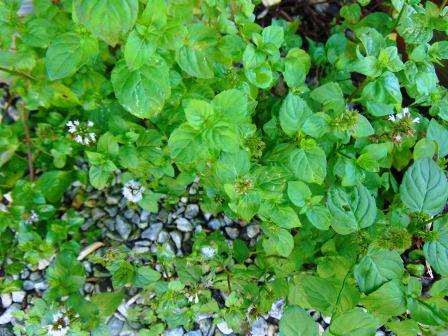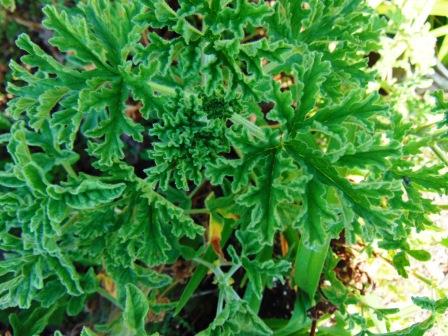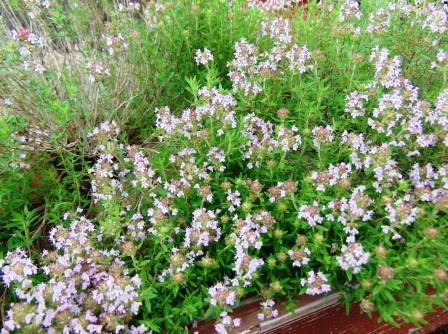As most of you know or may have guessed, I’m a tea addict so I’m always trying new combinations of herbs for tea blends. Actually, my entire passion for herbs began with tea herbs when I impulsively picked up a copy of Adelma Simmon’s book “Herb Gardens of Delight” way back in the early 60’s.  At the time, I was living in a city apartment and didn’t even have a garden, but that’s the way many dreams begin. If you can find a copy, get one! After reading the chapter on herbal teas, a concept totally unfamiliar to me since I’d only heard of “Lipton,” I ordered 4 plants from Adelma’s famous Connecticut herb farm, “Caprilands.” Rober’s lemon rose scented geranium, lemon verbena, lemon thyme and orange mint were my first herb garden, kept in pots on a city windowsill and they are still mandatory in my herb garden today. This massive
At the time, I was living in a city apartment and didn’t even have a garden, but that’s the way many dreams begin. If you can find a copy, get one! After reading the chapter on herbal teas, a concept totally unfamiliar to me since I’d only heard of “Lipton,” I ordered 4 plants from Adelma’s famous Connecticut herb farm, “Caprilands.” Rober’s lemon rose scented geranium, lemon verbena, lemon thyme and orange mint were my first herb garden, kept in pots on a city windowsill and they are still mandatory in my herb garden today. This massive  lemon verbena is actually a descendant of that original plant from Adelma. When it gets too big for me to drag back and forth indoors for the winter and out for the summer, I take new cuttings. This orange mint is also a descendant of those original four plants. The very first tea I ever
lemon verbena is actually a descendant of that original plant from Adelma. When it gets too big for me to drag back and forth indoors for the winter and out for the summer, I take new cuttings. This orange mint is also a descendant of those original four plants. The very first tea I ever  blended was Adelma’s recipe for “Orange Mint Tea” and it still remains one of my very favorites. The recipe is simple: 1 qt. dried orange mint, the grated and dried rind of one orange and 1 lemon, 8 tsp. of black or green tea, 1 tsp. ground cloves, 1 cup dried calendula petals. It’s delicious, although not caffeine-free. Orange mint does not taste like the citrus, but like bergamot. It is a true mint, however, not a fruit or a monarda. There are so very many mints (I once had 37 different ones!) that just mint teas and blends could fill a book! Now I constrain myself to the must-have mints: orange, lime, apple, peppermint and spearmint.
blended was Adelma’s recipe for “Orange Mint Tea” and it still remains one of my very favorites. The recipe is simple: 1 qt. dried orange mint, the grated and dried rind of one orange and 1 lemon, 8 tsp. of black or green tea, 1 tsp. ground cloves, 1 cup dried calendula petals. It’s delicious, although not caffeine-free. Orange mint does not taste like the citrus, but like bergamot. It is a true mint, however, not a fruit or a monarda. There are so very many mints (I once had 37 different ones!) that just mint teas and blends could fill a book! Now I constrain myself to the must-have mints: orange, lime, apple, peppermint and spearmint.  Any scented geranium can be used for tea, but I prefer the rose, lime or lemon scents and Rober’s Lemon Rose (shown just above) is my absolute favorite. I simply drop a small leaf in a cup of green tea, quickly top it with a saucer and let it steep for 2 minutes. Done! Bigger leaves go into a teapot when I’m brewing more than one cup. Sweeten with a bit of honey if you must, but I prefer it plain. Another of my favorite teas is elderflower with a lime scented geranium. It’s almost like a warm, non-alcoholic Hugo! And if you like lemon, get a Mabel Grey scented geranium. It’s heavenly. Scented geranium leaves can be used fresh or dried, so the plant on my windowsill provides flavor for tea all winter, one way or another.
Any scented geranium can be used for tea, but I prefer the rose, lime or lemon scents and Rober’s Lemon Rose (shown just above) is my absolute favorite. I simply drop a small leaf in a cup of green tea, quickly top it with a saucer and let it steep for 2 minutes. Done! Bigger leaves go into a teapot when I’m brewing more than one cup. Sweeten with a bit of honey if you must, but I prefer it plain. Another of my favorite teas is elderflower with a lime scented geranium. It’s almost like a warm, non-alcoholic Hugo! And if you like lemon, get a Mabel Grey scented geranium. It’s heavenly. Scented geranium leaves can be used fresh or dried, so the plant on my windowsill provides flavor for tea all winter, one way or another.  Thyme is a traditional medicinal tea, but I’m not a huge fan of the flavor by itself. However, lemon thyme is entirely acceptable, especially when blended with other lemon-flavored herbs like lemon verbena, lemon balm or lemon grass. A cup in the cold of winter brings back summer memories of lemonade. The thyme in the photo is my favorite, “Lemon Mist” thyme.
Thyme is a traditional medicinal tea, but I’m not a huge fan of the flavor by itself. However, lemon thyme is entirely acceptable, especially when blended with other lemon-flavored herbs like lemon verbena, lemon balm or lemon grass. A cup in the cold of winter brings back summer memories of lemonade. The thyme in the photo is my favorite, “Lemon Mist” thyme.
Two years ago I purchased a fantastic tea in Germany, “Salbei-Honig-Vanille,” or sage, honey, vanilla. It is my favorite tea now, but I can’t go to Germany every time I want another box. So, I decided to replicate it using 2 c. of my own dried sage leaves, ½ c. honey powder, and snipped vanilla beans. The ingredients really need to age, and shaking every day helps spread the vanilla throughout the sage. If you want it sweeter, use more honey powder. Store it in a cool place, away from light. I use 1 tsp. tea mixture per cup of boiling water. You can see the crumbled sage leaves mixed with the honey powder, and the snipped vanilla beans below left. The finished product and a cup of the tea is on the right.

 Sage is an excellent tea herb, known for improving mental ability and good health, especially as one ages. It is an easy-to-grow perennial, requiring only good drainage and lots of sunshine. It can be started quickly from seed, or from cuttings.
Sage is an excellent tea herb, known for improving mental ability and good health, especially as one ages. It is an easy-to-grow perennial, requiring only good drainage and lots of sunshine. It can be started quickly from seed, or from cuttings.
 The flavor of sage can be strong, so you may prefer to combine it with mints, ginger, or other herbs to balance it for teas. Or, cut it with stinging nettle, lemon grass, raspberry leaves, strawberry leaves, or other mild but healthful herbs. I also like it with elderflower, but then I love elderflower tea by itself or with almost any other herb!
The flavor of sage can be strong, so you may prefer to combine it with mints, ginger, or other herbs to balance it for teas. Or, cut it with stinging nettle, lemon grass, raspberry leaves, strawberry leaves, or other mild but healthful herbs. I also like it with elderflower, but then I love elderflower tea by itself or with almost any other herb!
In summertime I just throw herbs in a gallon jar of water to steep as sun tea, but I’m also constantly drying herbs for the winter months. The upcoming cooler months are the perfect time to experiment with new tea blends, so be adventurous. Do keep a record of your trials, so you can duplicate successes, or revise blends to improve the flavor.

and they are so good for you. Long time ago we drank a lot of mint tea made from peppermint or spearmint. wasn’t to crazy for apple mint but the best is Tusi Basil….Oh my goodness…be still my heart.
LikeLiked by 1 person
Basil teas are not my favorite, although I’ve heard that in Australia basil tea is called “Housewife’s Tea” because it’s a good mid-morning pick-me-up. I do enjoy Cinnamon basil tea and clove basil tea, but Tulsi? Really? The hairy green one that self-seeds rampantly? Are we talking the same basil?
LikeLiked by 1 person
I’ll look it up and let you know for sure.
LikeLike
Ocimum sanctum…..Holy basil Tulsi We loved it and I need to grow it again.
LikeLike
Awesome post! I love herbs and love tea!
LikeLiked by 3 people
Carolee, this post is excellent and so helpful in planning which herbs to grow for tea. I’ll be on the lookout for some you’ve mentioned. Thank you!
LikeLiked by 3 people
Carolee – so many projects; so little time. I grew a few herbs this year – my first year of gardening in more than a decade. Quickly decided that I needed to do more herbs. I was inspired by another blog to purchase a particular book on herbs. And now you have inspired me to buy this one. Just placed my order! Planning the herb garden will be my winter project. Thanks so much for sharing!
LikeLiked by 2 people
I like the idea of sun teas and I certainly like tisanes, but I rarely remember to make them. This has got me inspired, thanks!
LikeLiked by 2 people
Love this article. We need to get together soon. (after fall clean-up!!) Maybe if I can ever get my gardens under control, man they grow fast here, then I will get some of these herbs. Never expected these plants to grow so fast here at the farm. Am going to have to dig, pull, throw away, or give away some of these things. I planted some balsam seeds, big mistake. Now they are everywhere. Am trying to pull them before the seed pods burst. Am throwing them on the back of the property where they can grow to their hearts content! I love the colors of the Balsam. If anyone wants what I’m getting rid of or seeds etc., let me know. Balsam, Rudbeckia Triloba, Amsonia, other rudbeckias, tall domestic asters, a number of different daylilies.
Bonnie
________________________________
LikeLiked by 1 person
Yes to getting together! Don’t need any more plants, but thanks anyway. I love balsam….always call it “Touch Me Not” the colors are gorgeous, but (sigh!) mostly pinkish and that doesn’t work for me!
LikeLike
This is an inspirational read! Just off to put the kettle on!
LikeLiked by 2 people
😍🙏🏻
LikeLiked by 2 people
I like hearing about your first herbal! Mine was A Country Diary Herbal. I still curl up with it sometimes. Right now my favorite tea herb is Anise Hyssop. And that’s good because I have a huge bunch drying in the basement! 😉
LikeLiked by 1 person
I have that book, too, and really like it. Anise Hyssop is next year’s Herb of the Year, so you’ll be finding lots of publications touting it. I have bunches drying as well to use in talks, etc. The butterflies certainly love it!
LikeLiked by 1 person
Just wondering what method works best for you when starting plants from cuttings?
LikeLiked by 1 person
Depends on the plant….scented geraniums go into moist sterile potting soil with no rooting hormone, tented with a loose sheet of plastic wrap or put in light shade until they root (being sure to check moisture daily and misting if showing signs of wilting.) Dry soil lovers like succulents and lavender, sage, thymes go into a damp porous soil and then into light shade with no tenting. I only use rooting hormone with things that take forever to root, like some shrub cuttings. Mints and much of their family can just be rooted in water.
LikeLike
Love this post. Thanks!
LikeLiked by 1 person
Glad you enjoyed it. Thanks for reading and taking time to comment.
LikeLike
Pingback: Herbal Teas — herbalblessingsblog – SEO
I love herbal teas. They’re so healthy and have so many benefits!
I’ve been having chamomile, spearmint, and lemon verbena this time of year. I’ll definitely have to look into growing my own herbs at one point
LikeLiked by 1 person